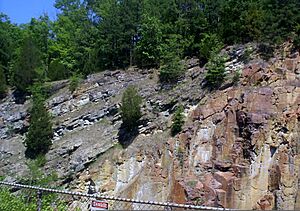Unconformity facts for kids
An unconformity is like a missing chapter in Earth's history book. It is a big gap in the layers of rock. Imagine a stack of books, but some pages or even whole chapters are gone!
In geology, an unconformity is a buried surface where erosion happened. It separates two rock layers that formed at very different times. This gap shows that new sediment stopped being laid down for a while. This often happens when land rises above sea level.
The older rock layer was usually exposed to wind and water for a long time. Then, new sediments were deposited on top of it. An unconformity can represent millions of years of missing time in the rock record.
The rocks above an unconformity are always younger than the rocks below. This is unless the layers have been flipped upside down. An unconformity means that no new sediments were saved in that area during that time.
Geologists call this missing time a hiatus. It means 'gap'. Scientists must look for other clues to understand what happened during these missing periods.
Contents
Discovering Unconformities
A famous Scottish geologist named James Hutton found important examples of unconformities. He saw them in Scotland at Jedburgh in 1787 and at Siccar Point in 1788. These discoveries helped scientists understand Earth's long history.
Types of Unconformities
There are different ways these "missing chapters" can appear in rock layers. Geologists classify unconformities based on how the rock layers above and below them are arranged.
Angular Unconformity
An angular unconformity is easy to spot. The older rock layers below the gap are tilted or folded. But the younger layers above the gap are flat or at a different angle. This shows that the older rocks were moved and eroded before the new layers formed.
Disconformity
A disconformity happens when the rock layers above and below the gap are parallel. They look like they should be continuous. However, there is a clear surface of erosion between them. This means there was a period of erosion or no deposition, but the layers stayed flat.
Nonconformity
A nonconformity is when younger sedimentary rocks are found on top of much older igneous or metamorphic rocks. These older rocks formed deep inside Earth and were later pushed up and eroded. Then, new sediments settled on top of them.
Paraconformity
A paraconformity is the hardest type to see. The layers above and below the gap are parallel, and there is no clear sign of erosion. Geologists can only tell there's a gap by looking at the fossils or by dating the rocks.
Images for kids
-
The Taconic Unconformity near Catskill, New York. This angular unconformity separates the Austin Glen Formation (Ordovician) from the overlying Rondout Formation (Silurian) and Manlius Formation (Devonian).
-
Eemian disconformity in a fossil coral reef on Great Inagua, The Bahamas. The front shows corals cut by erosion. Behind the geologist is a coral pillar that grew after the sea level rose again.
-
Disconformity with the Lower Cretaceous Edwards Formation on top of a Lower Permian limestone. The hiatus (gap) is about 165 million years in Texas.
-
Nonconformity between the Pennsylvanian Fountain Formation (left) and Precambrian gneiss (right) at Red Rocks Park, near Golden, Colorado.
-
Disconformity (at the hammer) between the older Mississippian Borden Formation and the younger Pennsylvanian Sharon Conglomerate, near Jackson, Ohio.
-
Angular unconformity of Triassic rocks on top of steeply-tilted Carboniferous rocks at Praia do Telheiro, Portugal.
See also
 In Spanish: Discordancia (geología) para niños
In Spanish: Discordancia (geología) para niños













